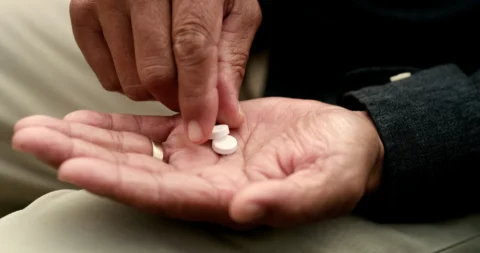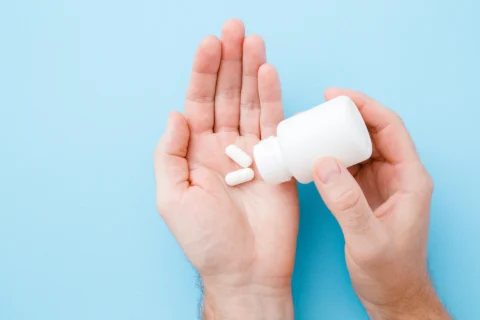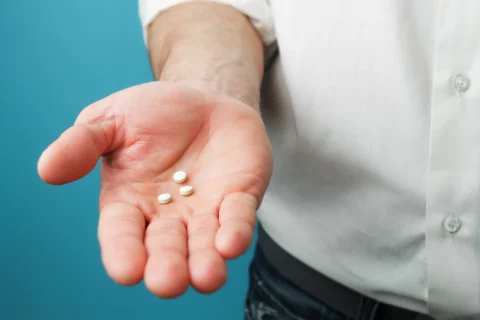Clomiphene citrate, commonly known by the brand name Clomid has gained popularity as an off-label treatment for male infertility and low testosterone levels.
So how quickly can men expect to see results from clomiphene treatment? In this article, we’ll explore the typical timeline for clomiphene to work in men, factors that influence its efficacy, and how it compares to other options.
Clomiphene for Men: How It Works

Clomiphene is a selective estrogen receptor modulator (SERM) that acts on the hypothalamus and pituitary gland in the brain.
It blocks estrogen receptors, which leads to an increase in luteinizing hormone (LH) and follicle-stimulating hormone (FSH) production. LH and FSH then travel through the bloodstream to the testicles, where they stimulate testosterone production and sperm development.
In men, clomiphene is usually prescribed to treat hypogonadism (low testosterone), improve sperm count and quality, and help achieve natural conception. It stimulates the body’s own hormone production rather than providing external testosterone.
Using Clomiphene to Increase Testosterone
One of the most common uses of clomiphene in men is boosting testosterone levels.
Studies show clomiphene therapy can increase testosterone. This is because it activates the hypothalamic-pituitary-gonadal axis to secrete more luteinizing hormone.
In clinical practice, men with symptomatic hypogonadism are often started on a daily dose of 25-50 mg clomiphene. Testosterone levels should be monitored at 1-2 month intervals to assess response and adjust the dosage accordingly.
Most men notice a significant increase in testosterone within 2-3 months. However, it can take up to 6 months to see the full testosterone-boosting benefits. The effects last as long as clomiphene is taken, with levels declining again upon discontinuation.
Using Clomiphene to Improve Sperm Quality
Clomiphene is also used to treat male factor infertility caused by low sperm concentrations, poor sperm motility, and low sperm counts.
The same mechanisms that stimulate testosterone also act on the testes to increase FSH levels. FSH is the primary driver of sperm production. With sustained use of clomiphene, FSH levels rise and initiate improved spermatogenesis.
On average, it takes around 3-4 months of clomiphene treatment to see optimal improvements in sperm parameters. This lengthy timeline is due to the natural sperm production cycle. It takes approximately 90-108 days for new sperm to fully develop and mature.
Studies have shown men taking clomiphene for 9 months can experience significant increases in sperm concentration and motility, along with modest improvements in morphology. The beneficial effects are relatively long-lasting.
Factors That Influence Clomiphene’s Speed of Action
While general timeframes exist, there is considerable individual variability in how quickly men respond to clomiphene treatment. Some of the factors that influence clomiphene’s efficacy and onset of action include:
- Baseline testosterone levels – Men with very low starting testosterone tend to respond more rapidly, some in as little as 1 month. Those with mild deficiencies may take longer.
- Age – Younger men generally see faster and more pronounced testosterone gains than older men when using clomiphene.
- Duration of hypogonadism – If testosterone has been low for many years, the testes may be less responsive to stimulation.
- Cause of infertility – Clomiphene is less effective for infertility stemming from severe cases of varicocele or genetic issues.
- Dosage – The standard starting dose is 25mg daily. Larger doses up to 50mg can increase speed of response.
- Medications – Concurrent use of opioids, steroids, or similar drugs can interfere with clomiphene’s mechanisms.
- Medical conditions – Chronic illness, obesity, poor lifestyle habits, and conditions like diabetes or heart disease may blunt response.
- Consistency – Taking clomiphene regularly, for at least 3-4 months, produces better outcomes.
Therefore, men should be patient when starting clomiphene therapy and give it adequate time to work. Monitoring progress with lab tests helps determine if dosage adjustments or additional treatments are needed.
Potential Side Effects of Clomiphene for Men
Clomiphene is generally well tolerated, but some men may experience adverse effects like:
- Hot flashes, headache, fatigue
- Vision changes, blurred vision (reversible)
- Acne, rash
- GI upset, nausea
- Breast tenderness, gynecomastia
- Mood changes, irritability
- Potential risk of cardiovascular or thromboembolic events
High doses or extended use increases the likelihood of side effects. Patients should follow up regularly with their doctor for monitoring and to minimize risks. Using the lowest effective dose can help reduce adverse events.
How Fast Do Other Testosterone Treatment Options Work?
For comparison, testosterone replacement therapy (TRT) via injections, gels, or pellets takes effect more rapidly than clomiphene.
Injectable forms of testosterone show maximal absorption within 24 hours, while transdermal methods take several days to produce peak levels. However, these introduce exogenous testosterone rather than stimulating natural production.
Other oral medications like enclomiphene also stimulate testosterone secretion but aren’t specifically FDA approved for men.
Anastrozole works by limiting estrogen, helping restore testosterone balance. But it doesn’t directly raise testosterone like clomiphene.
Conclusion: Be Patient, Monitor Progress

Men using clomiphene citrate to increase testosterone or sperm production parameters should be patient.
It often takes at least 2-3 months to see initial hormonal changes, and 3-4 months to observe improvements in sperm counts or quality. Continued use is key, as clomiphene must be taken regularly to maintain its effects on the hypothalamic-pituitary-gonadal axis.
Dosage adjustments, combination therapy, or alternate treatments may be warranted if a patient doesn’t respond sufficiently after 6 months of clomiphene.
Follow-up testing helps gauge treatment efficacy so that adjustments can be made. While not a quick fix, clomiphene offers a relatively safe, effective way to restore normal testosterone levels and improve fertility for many men.







